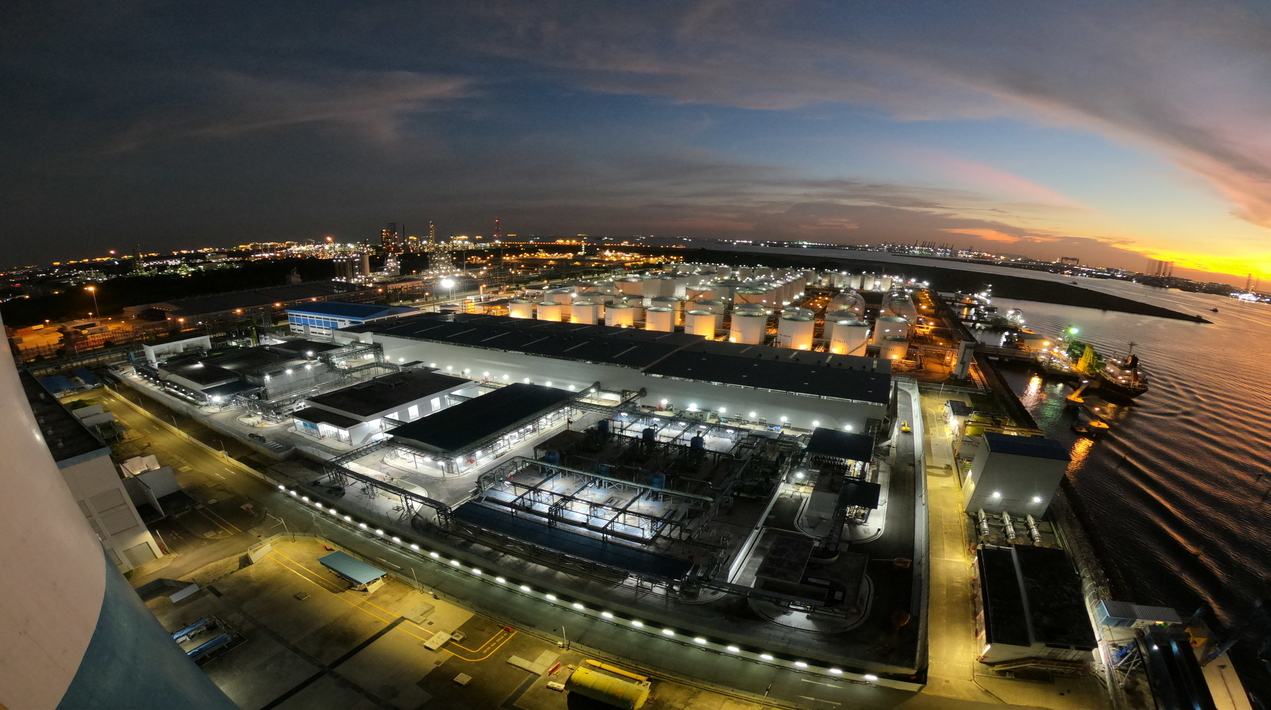
PUB, Singapore’s National Water Agency, along with a leading Singaporean electricity supplier and retailer and ST Engineering, officially launched Singapore’s fifth desalination plant located on Jurong Island. Jurong Island Desalination Plant (JIDP) has a daily capacity of up to 137,000 cubic metres (about 30 million gallons) – the equivalent of 55 Olympic-sized swimming pools of water.
Constructed under the Design, Build, Own and Operate (DBOO) model, JIDP will be operated by a joint venture company formed by the consortium for 25 years. Spanning over 3.7 hectares, which is about the size of five football fields, JIDP receives seawater from Tuas Power’s Tembusu MultiUtilities Complex (TMUC) for processing into potable water.
The plant’s co-location with TMUC allows it to derive synergies in resources such as sharing of seawater intake and outfall structures, as well as energy from in-plant generation facilities. Due to the co-location, the plant is about 5% more energy efficient compared to conventional desalination plants, which translates to annual energy savings sufficient to power nearly 1,000 HDB households.
Building a full-fledged desalination plant on existing infrastructure called for innovative engineering solutions, from creating modular systems in different areas of the desalination process to the pre-fabrication of equipment such as the reverse osmosis units.
The plant is also highly automated – a three-man team can run the entire plant’s operations from its control room. In addition, JIDP incorporates the latest proven water treatment equipment and membrane technologies such as dissolved air flotation, ultra-filtration, and reverse osmosis.
The Chief Executive of PUB stated that while seawater desalination is the most expensive way to produce water, due to the energy required, it is nevertheless an essential source of drinking water for Singapore. Desalination is immune to the vagaries of weather and always available, rain or not. He noted that the efficiencies that come from constructing JIDP, the region’s fifth and newest desalination plant, next to the energy company’s existing TMUC make the energy-take for desalination that much more palatable. JIDP further diversifies Singapore’s water production portfolio and its coming into operation enhances Singapore’s water security.
The design and construction of the JIDP have provided ST Engineering with the opportunity to leverage the engineers’ expertise in large scale engineering projects in the marine sector to deliver complex environmental engineering solutions. The result is an energy-efficient, technologically advanced, less labour intensive and weather-resilient water source that meets Singapore’s water needs, the President, Marine of ST Engineering said.
Meanwhile, the President and Chief Executive Officer of the energy company stated that by leveraging on TMUC’s existing infrastructure for seawater intake, the synergies between JIDP and TMUC have enabled operations to save approximately 5,000 Megawatt-hours per year. This is nearly 1,000 HDB households’ energy consumption annually, making JIDP one of the more energy-efficient desalination plants in Singapore, he shared.
Desalinated water is one of Singapore’s Four National Taps and a weather-resilient source that contributes to the nation’s long-term water supply sustainability. The other four desalination plants in Singapore are the Singspring (2005), Tuas South (2013), Tuas (2018) and Marina East (2020) plants.
Recent research notes that desalination technology has evolved over the years, and the desalination process has continued to grow increasingly cost-effective, emerging as a viable alternative means of sourcing freshwater to satisfy its burgeoning demand from different consumption sectors such as domestic, industrial and even lesser extent agriculture.
At present, developed economies and countries with acute water shortages are the dominant users of desalination, given the high cost and energy-intensiveness of these technologies. However, the future will see a massive mass-proliferation of desalination technologies as all countries will need to identify a guaranteed supply of safe water for their populations.
Amidst the COVID-19 crisis, the global market for Desalination Technologies is estimated at US$15.2 billion in 2022. It is projected to reach a revised size of US$ 22.5 billion by 2026, growing at a CAGR of 9.8% over the analysis period. Reverse Osmosis (RO) is projected to grow at an 11% CAGR to reach US$ 14.9 billion by the end of the analysis period.
















